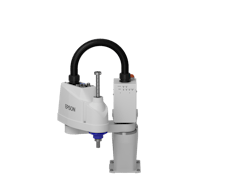New Epson robots offer price-competitiveness, user-friendliness
By Karen Hanna
Easier-to-use software could lower the barrier to implementation of upgraded robots from Epson.
Named for their payload capacities in kilograms, the company’s second-generation T3-B and T6-B All-in-One SCARA robots use both Epson RC+ programming language, as well as the Epson RC+ Express programming language, which works for simpler applications and requires no knowledge of coding.
“We already had our RC+ environment that our customers tell us is really easy to use. It's really a PC-kind of based environment,” said Aaron Donlon, a product manager for Epson robots. “And then we add Express onto it on top, which is just a really easy interface for people to see what's going on.”
With the introduction of RC+ Express, Donlon believes Epson has unleashed new robots that are more accessible.
“Maybe it eliminates a barrier where either you know that your programming [of] it is a barrier, or, if you put it on your production floor and there's zeros and ones moving around, it's going to make [other] people nervous. But we're all used to this tablet kind of format now, due to smartphones and tablets and everything else,” he said.
In developing the robots, Epson studied the issues that inhibit companies from investing in automation or fully benefiting from it, including, Donlon said, space constraints and price.
About half of Epson’s customers are new to automation, Donlon said.
“One of the pain points is the high total cost of integration and installation. You get into the cost of your robot, but you still have to install it, you still have to have somebody integrate it, or even program that yourself. Really, the cost of an overall production cell, the robot is just one percentage of that,” he said.
Compared with Cartesian-style gantry robots, the T-series line of robots is compact and easier to maintain and install, Donlon said. The robots are designed with a built-in controller at their base, eliminating the need for separate controller cooling.
With a Cartesian, “there's just a lot of complexity that comes with it,” said Donlon, in explaining the advantages of Epson’s simpler T-series.
“Even for these highest-end customers, they still see the value of a simple robot that's doing these simple applications,” he said.
That’s the niche the T-series robots fill.
According to Donlon, the robots are cost-effective and easy to install and integrate. They feature better motion control and are capable of shorter cycle times than their predecessors. At a time of unprecedented supply chain hurdles, Epson also has focused on making sure they’re easily available — with delivery in just weeks, thanks to Epson's vertically integrated production process.
The robots come in 110- and 220-volt versions.
Priced at less than $10,000, the T-series robots represent an entry-level option among Epson’s offerings. But there are plenty of applications that will fit well with them, Donlon said.
“The engineers over in Japan really knocked the ball out of the park with this one,” he said, “with a great solution without making things too crazy complex.”
Karen Hanna, senior staff reporter
[email protected]Contact:
Epson America Inc., Los Alamitos, Calif., 800‑463‑7766, https://epson.com
